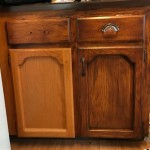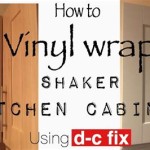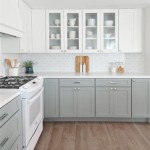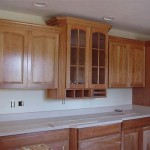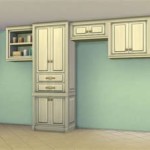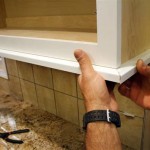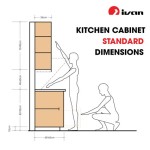```html
Rating Kitchen Cabinets: A Comprehensive Guide
Kitchen cabinets represent a significant investment in any home renovation project. Choosing the right cabinets involves careful consideration of factors such as material, construction quality, style, and price. This article provides a framework for evaluating and rating kitchen cabinets, enabling informed decision-making.
Material Composition and Durability
The materials used in cabinet construction directly impact their durability, aesthetics, and price point. Common materials include solid wood, plywood, particleboard, and medium-density fiberboard (MDF). Each material possesses distinct advantages and disadvantages.
Solid Wood: Solid wood cabinets are often considered the highest quality option. They offer natural beauty, inherent strength, and longevity. Hardwoods like maple, oak, cherry, and walnut are preferred for their density and resistance to dents and scratches. Softwoods, such as pine, are more susceptible to damage. Solid wood cabinets are typically more expensive than alternative options. Furthermore, solid wood can expand and contract with changes in humidity, potentially leading to warping or cracking if not properly sealed and maintained.
Plywood: Plywood consists of multiple layers of wood veneer glued together. This construction provides excellent stability and resistance to warping, making it a robust material for cabinet boxes and drawers. High-quality plywood, characterized by a greater number of plies and void-free construction, offers superior structural integrity. Plywood is generally more expensive than particleboard or MDF but represents a good balance of cost and durability.
Particleboard: Particleboard is manufactured from wood chips and resin, compressed into sheets. It is a cost-effective material commonly used for cabinet boxes and shelving. However, particleboard is less durable than solid wood or plywood and is particularly vulnerable to water damage. Once exposed to moisture, particleboard can swell and lose its structural integrity. High-density particleboard offers improved strength and moisture resistance compared to standard particleboard.
Medium-Density Fiberboard (MDF): MDF is an engineered wood product similar to particleboard but with a smoother surface and greater density. It is made from wood fibers and resin, compressed under high pressure. MDF is a stable material that resists warping and cracking. It is often used for cabinet doors and drawer fronts, providing a smooth surface for painting or laminating. While more moisture-resistant than particleboard, MDF is still susceptible to damage from prolonged exposure to water.
Cabinet ratings should reflect the material composition, with higher ratings awarded to cabinets constructed from solid wood or high-quality plywood. Factors such as wood species, ply count (for plywood), and density (for particleboard and MDF) contribute to the overall material rating.
Construction Methods and Joinery
The way in which cabinet components are joined together significantly affects their strength and longevity. Common construction methods include framed and frameless (also known as European-style) construction. Joinery techniques include dovetail joints, mortise and tenon joints, and dado joints.
Framed Cabinets: Framed cabinets feature a face frame, typically made of solid wood, that is attached to the front of the cabinet box. This frame provides structural support and a surface for attaching doors and drawers. Framed cabinets are often considered more traditional in style and offer a wide range of door and drawer options. The face frame can be either full overlay, where the doors and drawers cover most of the frame, or partial overlay, where a portion of the frame is visible. Inset doors and drawers fit flush with the face frame, creating a clean, contemporary look.
Frameless Cabinets: Frameless cabinets, also known as European-style cabinets, lack a face frame. The doors and drawers attach directly to the cabinet box. This construction method maximizes interior storage space and creates a sleek, modern aesthetic. Frameless cabinets typically feature full overlay doors and drawers. The absence of a face frame requires precise construction and high-quality hardware to ensure structural integrity.
Dovetail Joints: Dovetail joints are considered the strongest and most durable type of joinery. They are commonly used to connect drawer boxes, creating a tight, interlocking connection that resists pulling apart. Dovetail joints are a hallmark of high-quality cabinet construction.
Mortise and Tenon Joints: Mortise and tenon joints are frequently used to connect face frame components. These joints involve a projecting tenon that fits into a corresponding mortise, creating a strong and durable connection. Mortise and tenon joints are more robust than simple butt joints and contribute to the overall strength of the cabinet frame.
Dado Joints: Dado joints are used to secure shelves and cabinet backs to the cabinet box. These joints involve a groove (dado) cut into the cabinet side, into which the shelf or back panel is inserted. Dado joints provide additional support and prevent shelves from sagging. Cabinets with dadoed shelves are generally considered more durable than those with simply nailed or screwed shelves.
Cabinet ratings should consider the construction method and joinery techniques employed. Higher ratings are given to cabinets with framed construction using mortise and tenon joints, frameless construction with precisely aligned components, and drawers featuring dovetail joints. The presence of dadoed shelves and sturdy cabinet backs also contributes to a higher rating.
Finish Quality and Aesthetic Appeal
The finish applied to kitchen cabinets plays a crucial role in their appearance, durability, and ease of maintenance. Common finishes include paint, stain, and laminate. The quality of the finish application and the underlying surface preparation significantly impact the overall aesthetic appeal and longevity of the cabinets.
Paint: Painted cabinets offer a wide range of color options and can be easily customized to match any kitchen décor. High-quality paint finishes are typically applied in multiple layers, with sanding between each layer to create a smooth, even surface. Durable paint finishes resist chipping, scratching, and fading. Look for cabinets with a baked-on or catalyzed finish, which provides enhanced durability and resistance to chemicals and moisture.
Stain: Stained cabinets highlight the natural beauty of the wood grain. Stain penetrates the wood surface, enhancing its color and texture. A clear topcoat, such as varnish or lacquer, is typically applied over the stain to protect the wood and provide a durable, easy-to-clean surface. The quality of the stain application and the type of topcoat used influence the overall appearance and durability of the finish. Cabinets with a uniform stain application and a scratch-resistant topcoat receive higher ratings.
Laminate: Laminate cabinets are typically constructed from particleboard or MDF, with a decorative laminate surface applied to the exterior. Laminate is a durable and cost-effective material that is available in a wide range of colors and patterns. High-pressure laminate (HPL) is more durable than low-pressure laminate (LPL) and is recommended for high-use areas, such as kitchen cabinets. The edges of laminate cabinets are typically finished with edge banding to protect the core material from moisture and impact damage. The quality of the edge banding and its adhesion to the cabinet surface are important considerations.
In addition to the type of finish, the aesthetic appeal of kitchen cabinets is also influenced by door style, hardware selection, and overall design. Common door styles include Shaker, raised panel, flat panel, and slab doors. The choice of door style depends on personal preference and the desired kitchen aesthetic. Hardware, such as knobs and pulls, can also enhance the overall look of the cabinets. High-quality hardware is typically made of durable materials, such as stainless steel or brass, and features a smooth, even finish.
Cabinet ratings should reflect the quality of the finish application, the durability of the finish material, and the overall aesthetic appeal of the cabinets. Cabinets with a smooth, even finish, durable topcoat, and well-chosen hardware receive higher ratings. The door style and overall design should also be considered when evaluating the aesthetic appeal of kitchen cabinets.
Ultimately, rating kitchen cabinets requires a balanced assessment of material composition, construction quality, and aesthetic appeal. Understanding these factors empowers homeowners to make informed decisions and select cabinets that meet their specific needs and preferences.
```
Modular Kitchen Cost Per Sq Ft How Much Should You Budget

Accurate Rate For 4 Types Of Kitchen Cabinet Malaysia

Material Wooden Appearance Modern Kitchen Cupboard At Best In Chennai

Kitchen Design 350 Modular At Best In 2024 Kitchens Ideas

Kitchen Cabinet S Pictures Options Tips Ideas

11 Best Kitchen Cabinets In 2024 Our Top Picks

Aluminium Kitchen Cabinet At Rs 380 Square Feet Uppal Hyderabad Id 21823621830

Birch Vs Maple Cabinets What S Best For Your Kitchen

First Rate Kitchen Cabinets In Airport Residential Area Furniture Interior Deco Boutiques Jiji Com Gh

7 Best Kitchen Cabinet Materials To Protect You From Poor Quality Horrors
Related Posts

